Comparison of Fracture Toughness in the Coarse-Grain Heat-Affected Zone of X80 Pipelines Girth-Welded under Conventional and Ultra-Low Heat Input
Abstract
1. Introduction
2. Materials and Methods
3. Results and Discussion
3.1. Fracture Toughness (CTOD)
3.2. Microstructural Analysis
3.3. EBSD Analysis
3.4. Fracture Behavior Analysis
4. Conclusions
Author Contributions
Funding
Institutional Review Board Statement
Informed Consent Statement
Data Availability Statement
Conflicts of Interest
References
- Cai, Z.; Xu, J.; Wei, B.; Sun, C. A comparative study of sulfate-reducing desulfovibrio desulfuricans induced corrosion behaviors in Q235, X65, X70, and X80 pipeline steels. Int. J. Pres. Ves. Pip. 2022, 195, 104599. [Google Scholar] [CrossRef]
- Liu, S. Research status of corrosion environment failure and safety assessment of pipeline welded joint. Baosteel Tech. Res. 2021, 4, 41–47. [Google Scholar]
- Yang, H.H.; Shi, L.; Xu, Z.; Lu, H.; Chen, X.; Wang, X. Fracture toughness of the materials in welded joint of X80 pipeline steel. Eng. Fract. Mech. 2015, 148, 337–349. [Google Scholar] [CrossRef]
- Li, Z.L.; Chen, L.; Li, Z.H.; Yan, G.S.; Li, W. Experiment and simulation analysis of the pressure carrying capacity of X80 pipe with metal loss defect on the girth weld. Mater. Sci. Forum 2021, 1035, 813–818. [Google Scholar] [CrossRef]
- Khalaj, G.; Yoozbashizadeh, H.; Khodabandeh, A.; Tamizifar, M. Austenite grain growth modelling in weld heat affected zone of Nb/Ti microalloyed linepipe steel. Mater. Sci. Technol. 2014, 30, 424–433. [Google Scholar] [CrossRef]
- Pouraliakbar, H.; Khalaj, G.; Jandaghi, M.R.; Khalaj, G.; Khalaj, M.J. Study on the correlation of toughness with chemical composition and tensile test results in microalloyed API pipeline steels. J. Min. Metall. Sect. B Metall. 2015, 51, 173–178. [Google Scholar] [CrossRef]
- Avila, J.A.; Ruchert, C.O.F.T.; Mei, P.R.; Marinho, R.R.; Paes, M.T.P.; Ramirez, A.J. Fracture toughness assessment at different temperatures and regions within a friction stirred API 5L X80 steel welded plates. Eng. Fract. Mech. 2015, 147, 176–186. [Google Scholar] [CrossRef]
- Claudio, R.; Diego, F.B.S.; Eduardo, H.J. Fracture resistance testing of pipeline girth welds with strength undermatch using low-constraint specimens. Procedia Struct. Integr. 2019, 18, 36–45. [Google Scholar]
- Liu, S. Girth weldability and welding process of Baosteel X80 UOE linepipes. Baosteel Tech. Res. 2010, 3, 15–19. [Google Scholar]
- Li, Z.W.; Gong, B.M.; Giuseppe, L.; Deng, C.; Wang, D. Strain-based fracture response of X80 steel pipe welded girth based on constraint-modified J-R curves: From SENT specimen to full-scale pipe. Eng. Fract. Mech. 2021, 258, 108114. [Google Scholar] [CrossRef]
- Huilin, Z.; Changjiang, W.; Xuemei, Y.; Xinsheng, W.; Ran, L. Automatic welding technologies for long-distance pipelines by use of all-position self-shielded flux cored wires. Nat. Gas Ind. B 2014, 1, 113–118. [Google Scholar] [CrossRef]
- Cao, Y.G.; Chang, Q.; Zhen, Y. Numerical simulation of fracture behavior for the pipeline with girth weld under axial load. Eng. Fract. Mech. 2022, 136, 106221. [Google Scholar] [CrossRef]
- Xu, S.; Tyson, W.R.; Duan, D.M. ECA of embedded flaws in pipeline girth welds—A review. Int. J. Pres. Ves. Pip. 2019, 172, 79–89. [Google Scholar] [CrossRef]
- Qiaoling, C.; Shuai, X.; Xionawei, T.; Jie, L.; Min, Z.; Fuxue, Y.; Wanpeng, Z.; Zongyue, B.; Cheng, Y. Comparative study of microstructure and mechanical properties of X80 SAW welds prepared using different wires and heat inputs. J. Mater. Eng. Perform. 2020, 29, 4322–4338. [Google Scholar]
- Liu, S. Evaluation of automatic girth weldability of pipeline in special conditions. Baosteel Tech. Res. 2021, 15, 1–10. [Google Scholar]
- Buzzatti, D.T.; Kanan, L.F.; Dalpiaz, G.; Scheid, A.; Fortis, C.E. Effect of heat input and heat treatment on the microstructure and toughness of pipeline girth friction welded API 5L X65 steel. Mater. Sci. Eng. A 2022, 833, 142588. [Google Scholar] [CrossRef]
- Di, X.; Tong, M.; Li, C.; Zhao, C.; Wang, D. Microstructural evolution and its influence on toughness in simulated inter-critical heat affected zone of large thickness bainitic steel. Mater. Sci. Eng. A 2019, 743, 67–76. [Google Scholar] [CrossRef]
- Luo, X.; Chen, X.; Wang, T.; Pan, S.; Wang, Z. Effect of morphologies of martensite–austenite constituents on impact toughness in intercritically reheated coarse-grained heat-affected zone of HSLA steel. Mater. Sci. Eng. A 2018, 710, 192–199. [Google Scholar] [CrossRef]
- Li, X.; Fan, Y.; Ma, X.; Subramanian, S.V.; Shang, C. Influence of Martensite—Austenite constituents formed at different intercritical temperatures on toughness. Mater. Des. 2015, 67, 457–463. [Google Scholar] [CrossRef]
- Lee, S.G.; Sohn, S.S.; Kim, B.; Kim, W.G.; Um, K.-K.; Lee, S. Effects of martensite-austenite constituent on crack initiation and propagation in inter-critical heat-affected zone of high-strength low-alloy (HSLA) steel. Mater. Sci. Eng. A 2018, 715, 332–339. [Google Scholar] [CrossRef]
- Wu, J.Y.; Wang, B.; Wang, B.X.; Misra, R.D.K.; Wand, Z.D. Toughness and ductility improvement of heavy EH47 plate with grain refinement through inter-pass cooling. Mater. Sci. Eng. A 2018, 733, 117–127. [Google Scholar] [CrossRef]
- Tong, M.; Di, X.; Li, C.; Wang, D. Toughening mechanism of inter-critical heat-affected zone in a 690 MPa grade rack plate steel. Mater. Charact. 2018, 144, 631–640. [Google Scholar] [CrossRef]
- Li, X.; Ma, X.; Subramanian, S.; Shang, C.J. EBSD characterization of secondary microcracks in the heat affected zone of a X100 pipeline steel weld joint. Int. J. Fract. 2015, 193, 131–139. [Google Scholar] [CrossRef]
- Moshtaghi, M.; Loder, B.; Safyari, M.; Willidal, T.; Hojo, T.; Mori, G. Hydrogen trapping and desorption affected by ferrite grain boundary types in shielded metal and flux-cored arc weldments with Ni addition. Int. J. Hydrogen Energy 2022, 47, 20666–20683. [Google Scholar] [CrossRef]
- Di, X.; An, X.; Cheng, F.J.; Wang, D.P.; Guo, X.J.; Xue, Z.K. Effect of martensite–austenite constituent on toughness of simulated inter-critically reheated coarse-grained heat-affected zone in X70 pipeline steel. Sci. Technol. Weld. Join. 2016, 21, 366–373. [Google Scholar] [CrossRef]
- Lan, L.; Qiu, C.; Zhao, D.; Guo, X.; Du, L. Microstructural characteristics and toughness of the simulated coarse grained heat affected zone of high strength low carbon bainitic steel. Mater. Sci. Eng. A 2011, 529, 192–200. [Google Scholar] [CrossRef]
- Wang, X.L.; Wang, X.M.; Shang, C.J.; Misra, R.D.K. Characterization of the multi-pass weld metal and the impact of retained austenite obtained through intercritical heat treatment on low temperature toughness. Mater. Sci. Eng. A 2016, 649, 282–292. [Google Scholar] [CrossRef]
- Sharma, T.; Kumar, N.N.; Mondal, R.; Krishna, K.V.M.; Samajdar, I.; Kain, V. Ductile-to-brittle transition in low-alloy steel: A combined experimental and numerical investigation. J. Mater. Eng. Perform. 2019, 28, 4275–4288. [Google Scholar] [CrossRef]
- Dong, Q.; Yang, P.; Xu, G. Low cycle fatigue analysis of CTOD under variable amplitude loading for AH-32 steel. Mar. Struct. 2019, 63, 257–268. [Google Scholar] [CrossRef]
- Lin, S.; Di, X.; Jiang, Y.; Wang, D.; Li, C.; Liu, X. Effect of cyclic plastic deformation on microstructure and mechanical properties of weld metals used for reel-lay pipeline steels. Mater. Sci. Eng. A 2018, 737, 77–84. [Google Scholar] [CrossRef]
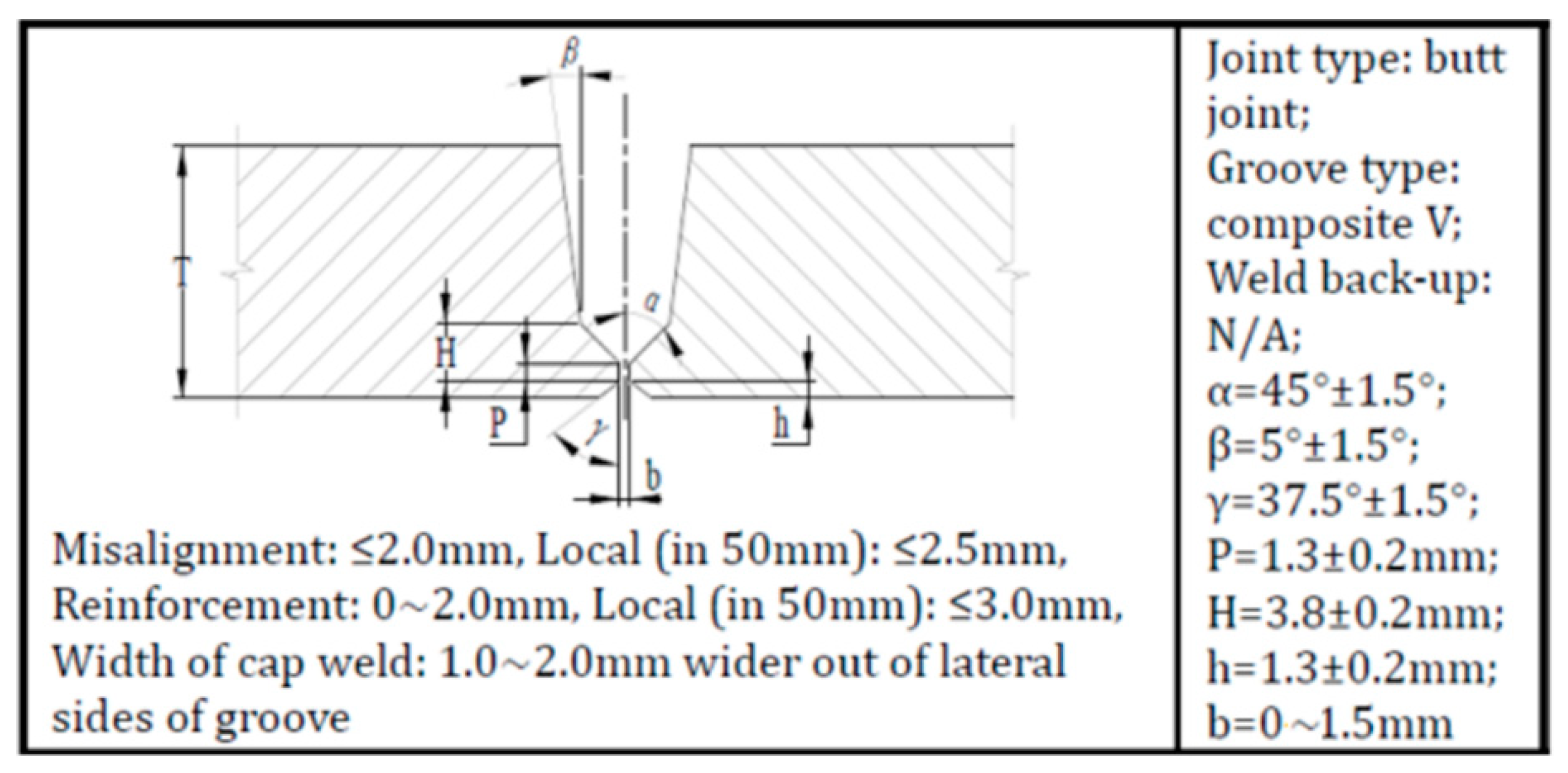
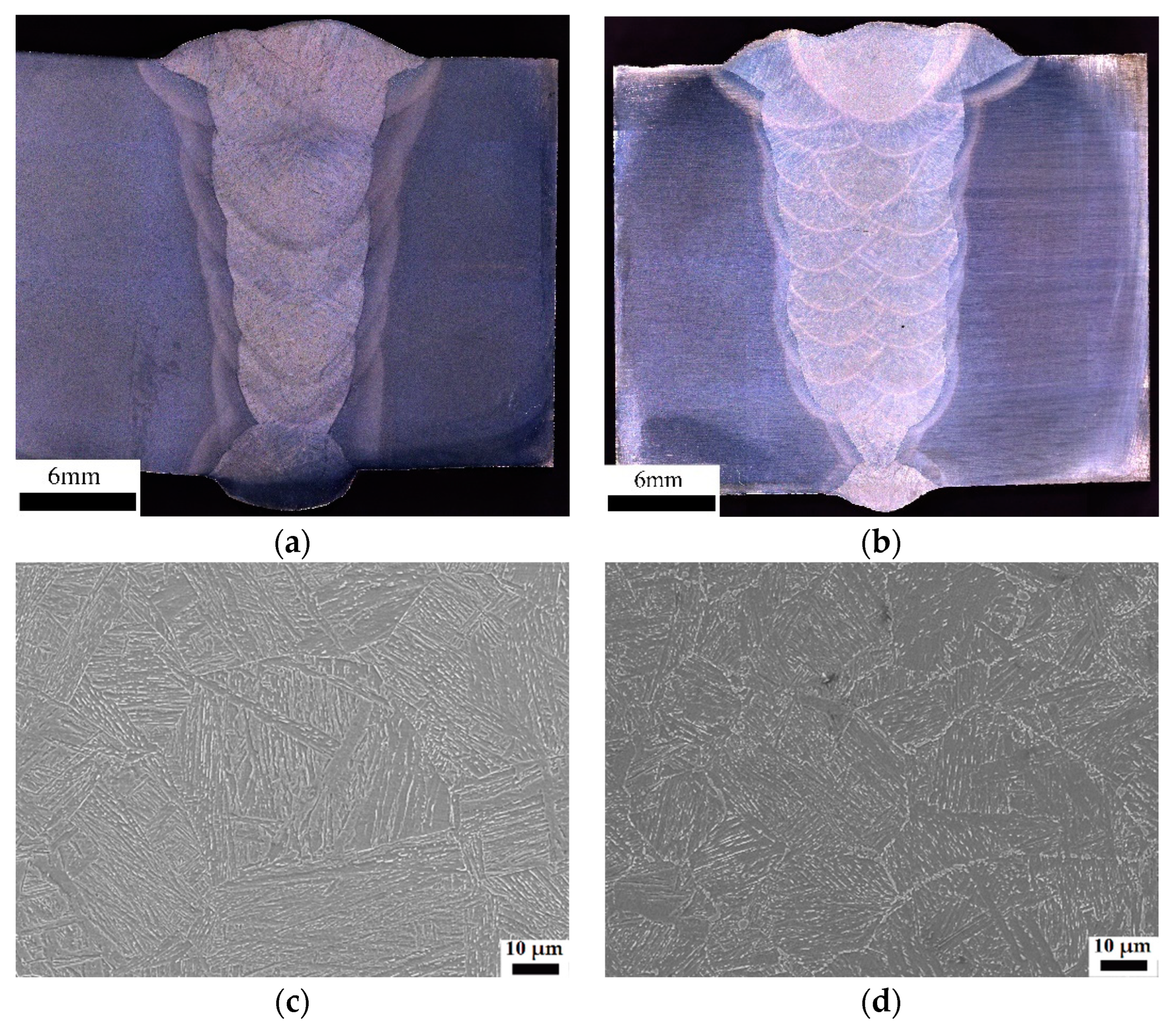
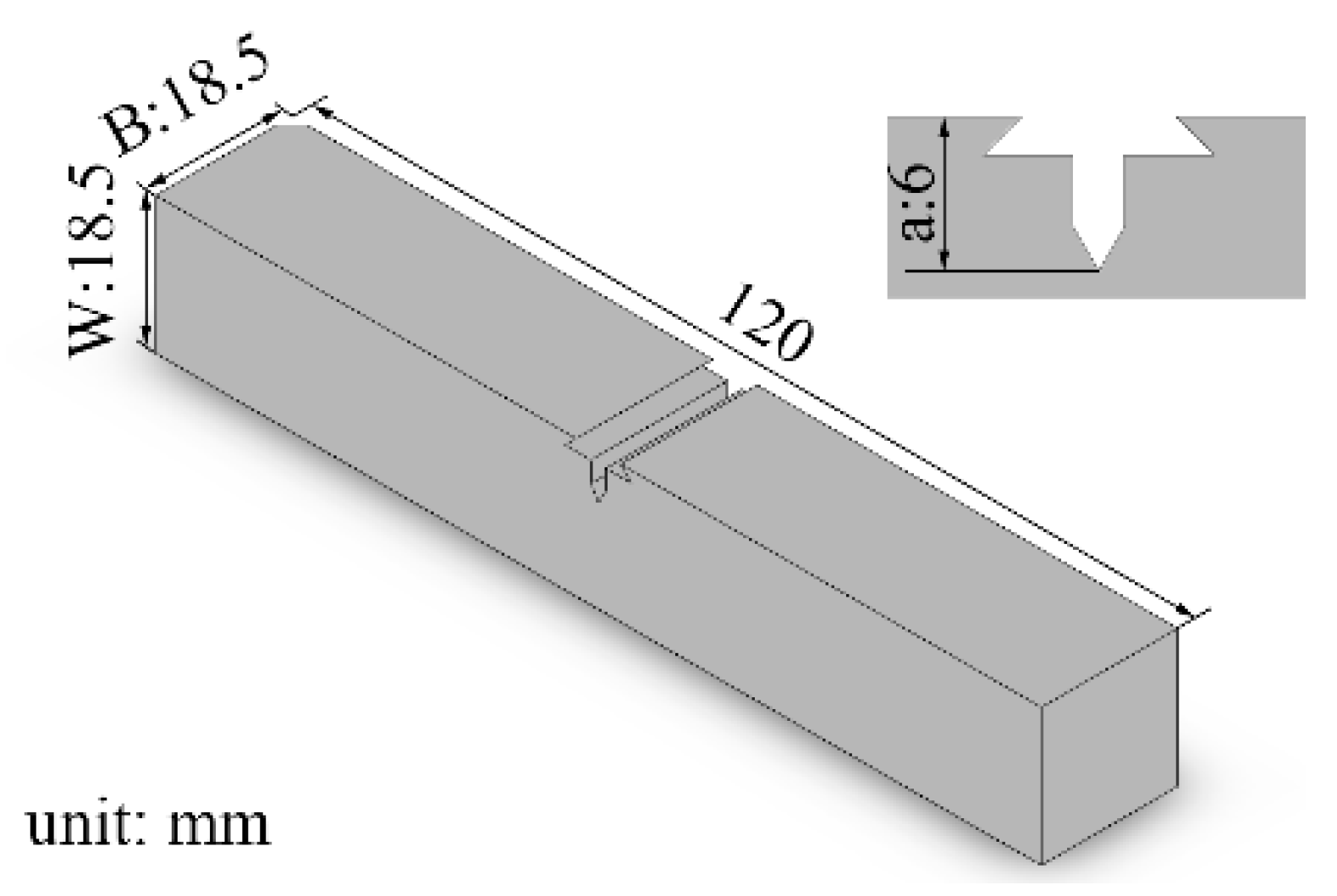

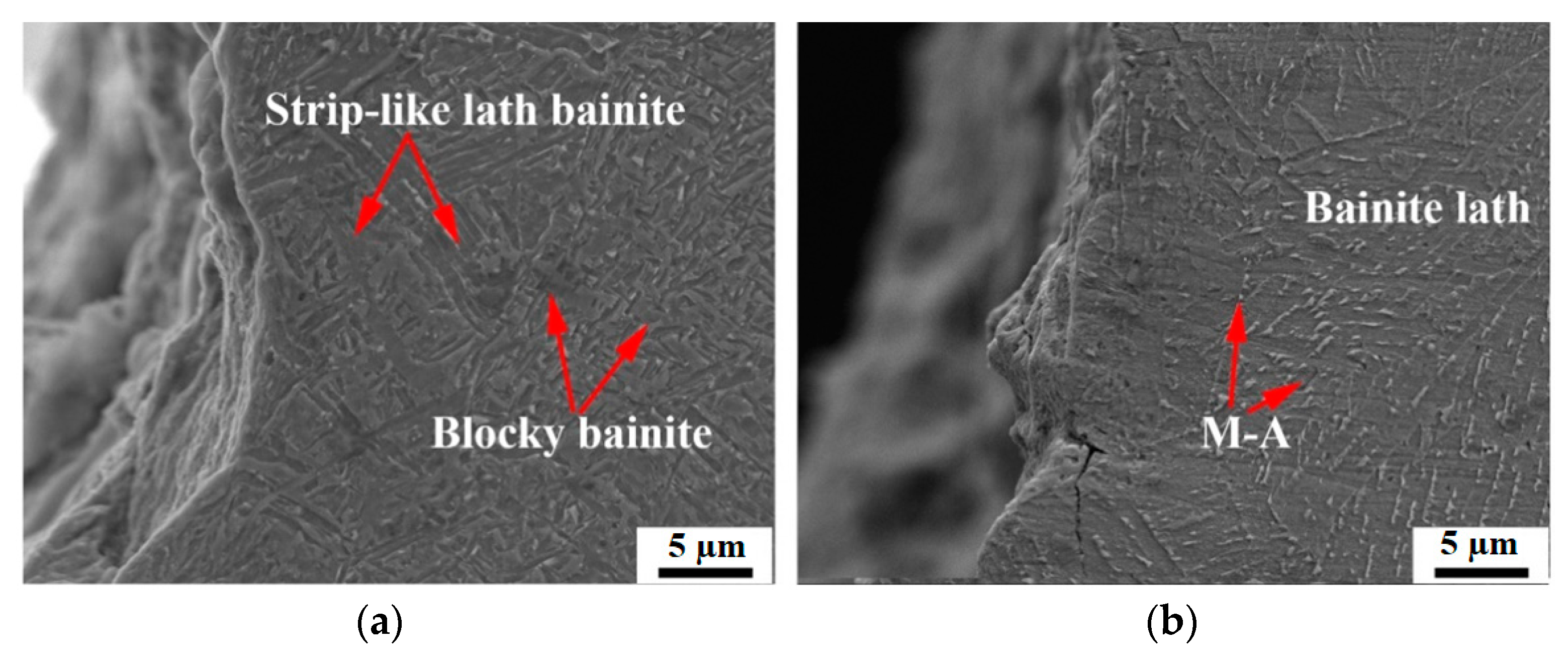
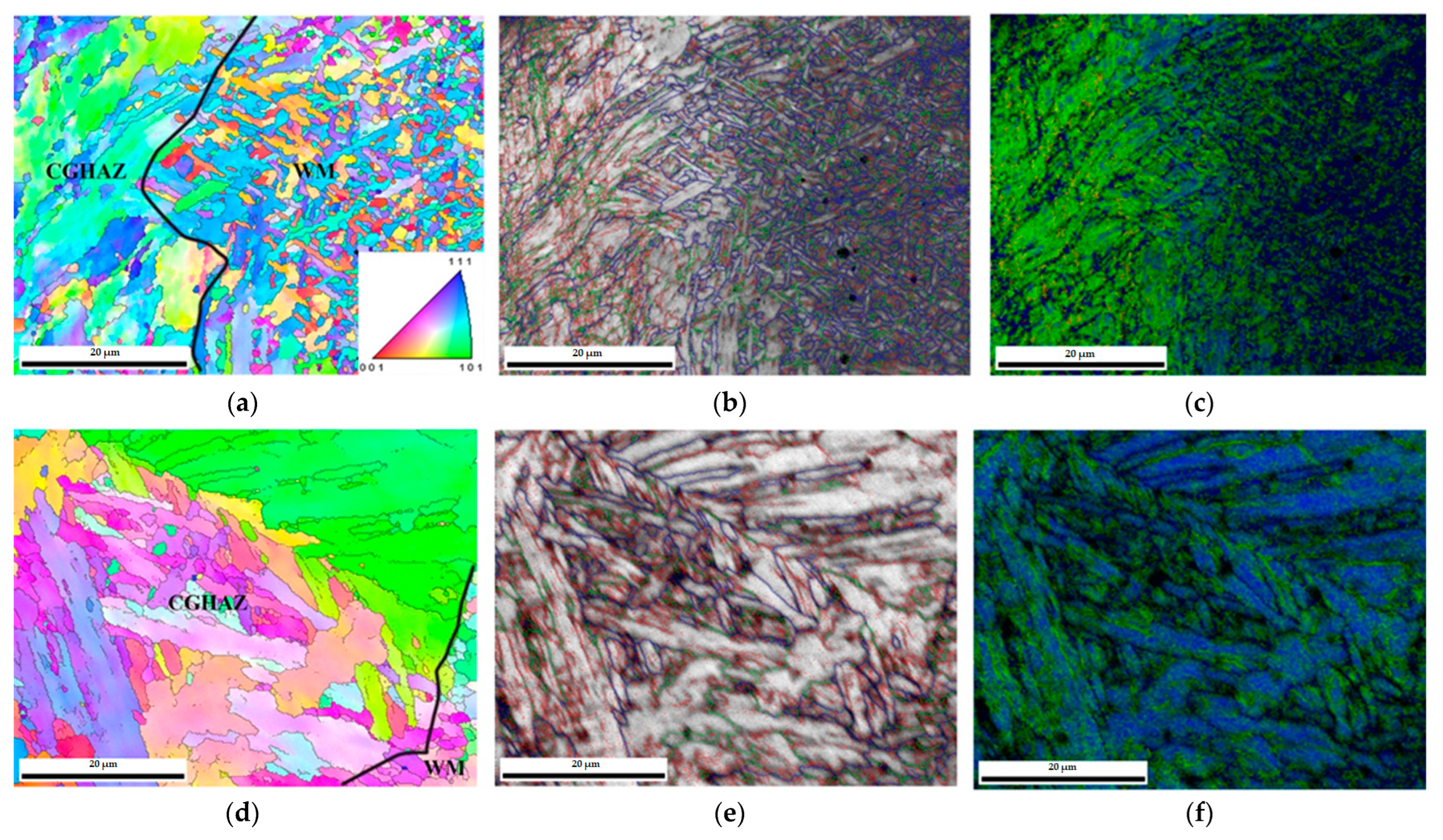
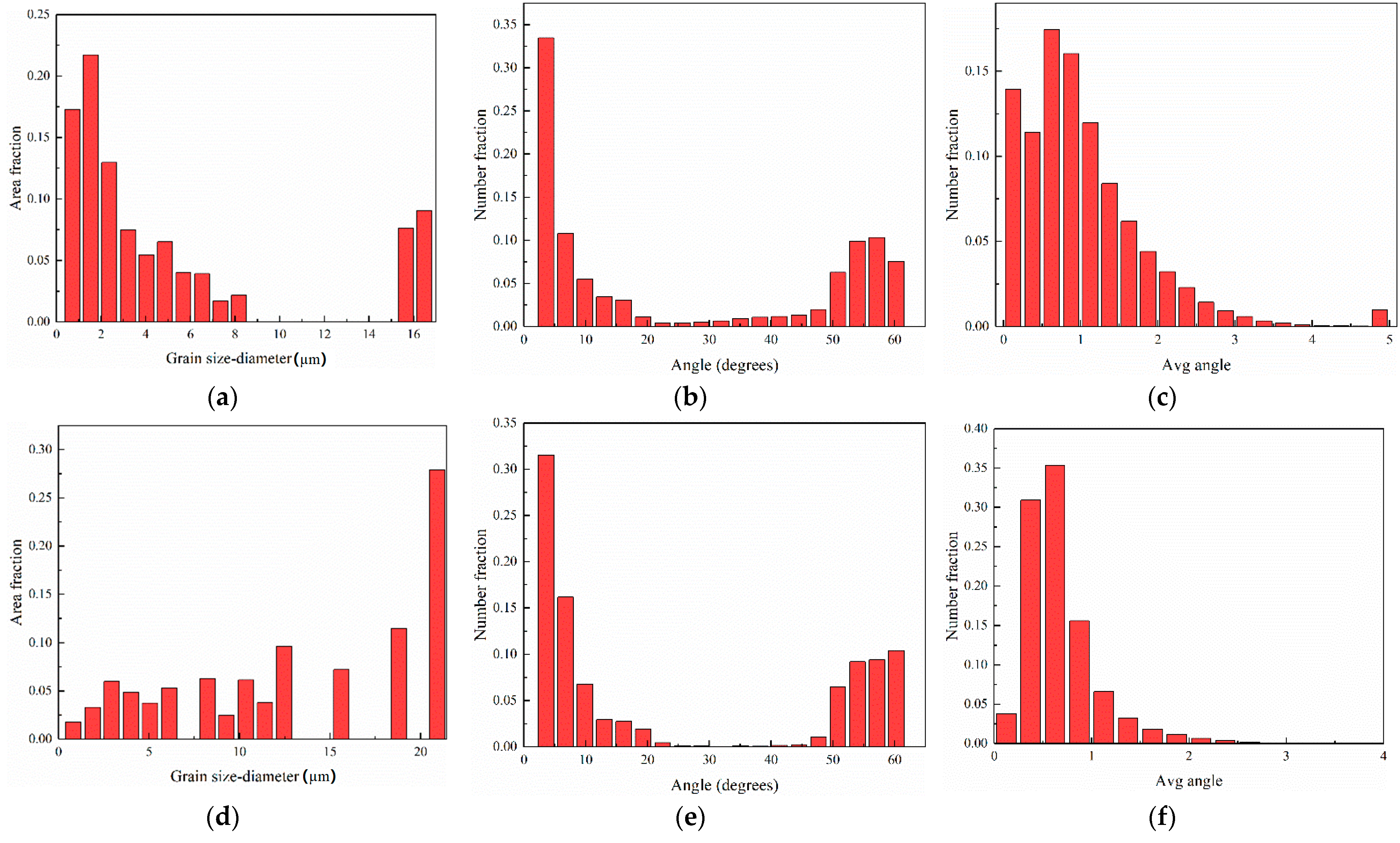
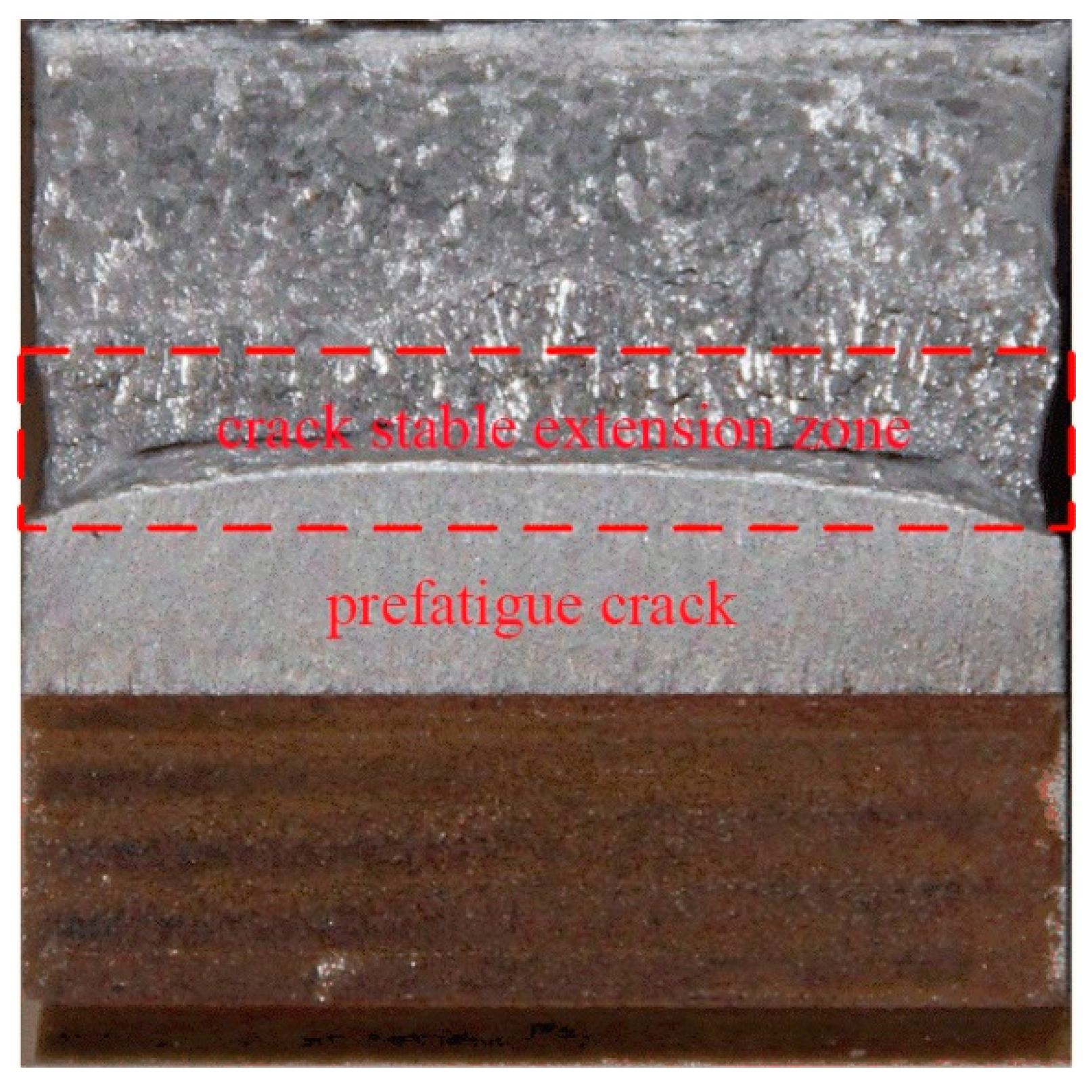

| C | Si | Mn | P | S | Cr | Ni | Nb | Ti | CEIIW | Pcm |
|---|---|---|---|---|---|---|---|---|---|---|
| 0.05 | 0.2 | 1.7 | <0.01 | <0.003 | 0.22 | 0.18 | 0.06 | 0.02 | 0.44 | 0.17 |
| Root Pass | Hot/Filler/Cap Pass | ||
|---|---|---|---|
| Specification | Type | Specification | Type |
| AWS A5.18 ER70S-G | Bohler SG3-P | AWS A5.18 ER80S-G | Bohler SG8-P |
| Sample No. | Pass | Weld Direction | Current (A) | Voltage (V) | Welding Speed (mm/min) | Heat Input (kJ/mm) |
|---|---|---|---|---|---|---|
| Ultra-low heat input | Root | Downward | 180–200 | 20–22 | 950 | 0.25 |
| Hot | 175–250 | 18–21 | 800–1200 | <0.25 | ||
| Filler | 175–250 | 18–21 | 800–1200 | <0.25 | ||
| Cap | 175–250 | 18–21 | 800–1200 | <0.25 | ||
| Conventionalheat input | Root | Downward | 180–200 | 19–21 | 700 | 0.33 |
| Hot | 160–240 | 22–26 | 380–510 | 0.65 | ||
| Filler | 150–240 | 22–26 | 330–460 | 0.71 | ||
| Cap | 150–210 | 20–25 | 410–600 | 0.50 |
| Ultra-Low Heat Input | Conventional Heat Input | |||||
|---|---|---|---|---|---|---|
| Sample No. | U-1# | U-2# | U-3# | N-1# | N-2# | N-3# |
| CTOD (δ, mm) | 0.61 | 0.61 | 0.58 | 0.06 | 0.01 | 0.03 |
| Valid/invalid | Valid | Valid | Valid | Valid | Valid | Valid |
| Welding No. | Height Difference (μm) | |
|---|---|---|
| CGHAZ-1 | CGHAZ-2 | |
| Ultra-low heat input | 3109 | 3592 |
| Conventional heat input | 475 | 195 |
Publisher’s Note: MDPI stays neutral with regard to jurisdictional claims in published maps and institutional affiliations. |
© 2022 by the authors. Licensee MDPI, Basel, Switzerland. This article is an open access article distributed under the terms and conditions of the Creative Commons Attribution (CC BY) license (https://creativecommons.org/licenses/by/4.0/).
Share and Cite
Liu, S.; Ba, L.; Li, C.; Di, X. Comparison of Fracture Toughness in the Coarse-Grain Heat-Affected Zone of X80 Pipelines Girth-Welded under Conventional and Ultra-Low Heat Input. Materials 2022, 15, 7701. https://doi.org/10.3390/ma15217701
Liu S, Ba L, Li C, Di X. Comparison of Fracture Toughness in the Coarse-Grain Heat-Affected Zone of X80 Pipelines Girth-Welded under Conventional and Ultra-Low Heat Input. Materials. 2022; 15(21):7701. https://doi.org/10.3390/ma15217701
Chicago/Turabian StyleLiu, Shuo, Lingzhi Ba, Chengning Li, and Xinjie Di. 2022. "Comparison of Fracture Toughness in the Coarse-Grain Heat-Affected Zone of X80 Pipelines Girth-Welded under Conventional and Ultra-Low Heat Input" Materials 15, no. 21: 7701. https://doi.org/10.3390/ma15217701
APA StyleLiu, S., Ba, L., Li, C., & Di, X. (2022). Comparison of Fracture Toughness in the Coarse-Grain Heat-Affected Zone of X80 Pipelines Girth-Welded under Conventional and Ultra-Low Heat Input. Materials, 15(21), 7701. https://doi.org/10.3390/ma15217701








